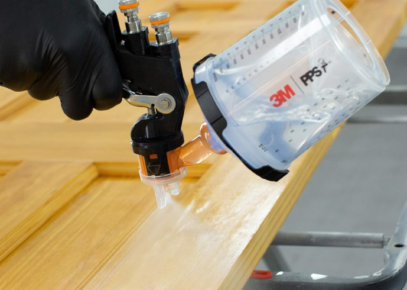Spray cans have one advantage over other automotive paint delivery methods – there’s no guesswork when it comes to mixing your paint. It’s all handled beforehand, so when you get a can of touch-up paint from Rondex, you can rest assured that the paint itself is ready for the job.
Professional car painters spend hundreds of hours perfecting their craft. To replicate the results that they get, you’ll have to be prepared to invest some work. Above all, you need to be patient and pay attention to detail. If you can do these things, an excellent touch-up job is within your capability.
As we’ve stated, step 1 is to prep the area you’re going to paint. It should be isolated from the adjacent areas of the car by tape and paper. Plan to “feather” your paint outside the area of the repair, ideally to the edge of a panel or a molding line on the car. This will avoid a visible line appearing in the middle of a panel. Paint should be applied to a clean, dry, primed surface.
Because you’re not painting in the controlled climate of a commercial paint booth, you need to be careful about temperature and humidity. Paint needs to be applied above 50 degrees F., with an ideal target of 70. If the relative humidity is above 50%, put off the painting until later.
It’s a good idea to practice your technique away from your car – find a piece of metal or plastic that you don’t love to practice on. To coat the surface, your nozzle should be 9-12 inches away (depending on a lot of variables – the goal is to evenly coat the surface with wet paint. If you’re too close, it will not be even. Too far away, and the paint will dry before it reaches the surface, and not adhere very well.
Coats should be even, and not so thick that the paint runs or sags if you’re painting a vertical surface. If a run or drip does occur, don’t try and wipe it off. You can get it at the sanding stage. Paint in “pulses”, keeping the nozzle of the can moving at a uniform speed.
You’ll need at least one “wet” coat, and likely two. These foundation coats should dry for a minimum of 20 minutes before recoating. Sand between coats with 1000 grit wet/dry sandpaper. The final base coat should not be sanded when applied. Let it cure overnight before applying clearcoat.
Clearcoat is applied in the same manner that the base is. You can wet sand out imperfections between coats, but allow the final coat to cure for three days before you give it a final surface with rubbing compound. This will give it a deep lustre, match the factory finish of the rest of the car quite nicely, and make all the work you’ve put into your touch-up worthwhile.




